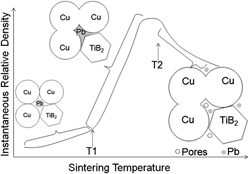Crossref Citations
This article has been cited by the following publications. This list is generated based on data provided by
Crossref.
Raju, G.B.
and
Basu, B.
2008.
Development of High Temperature TiB<sub>2</sub>-Based Ceramics.
Key Engineering Materials,
Vol. 395,
Issue. ,
p.
89.
Sharma, Amit S.
Mishra, Nisha
Biswas, Krishanu
and
Basu, Bikramjit
2013.
Fretting wear study of Cu–10wt% TiB2 and Cu–10wt% TiB2–10wt% Pb composites.
Wear,
Vol. 306,
Issue. 1-2,
p.
138.
Siddharth Sharma, Amit
Biswas, Krishanu
and
Basu, Bikramjit
2014.
Microstructure-hardness-fretting wear resistance correlation in ultrafine grained Cu–TiB2–Pb composites.
Wear,
Vol. 319,
Issue. 1-2,
p.
160.
Shuai, Cijun
Duan, Songlin
Wu, Ping
Gao, Dan
Feng, Pei
Gao, Chengde
and
Peng, Shuping
2016.
Development of bioceramic bone scaffolds by introducing triple liquid phases.
Journal of Materials Research,
Vol. 31,
Issue. 22,
p.
3498.
Jung, Im Doo
Ha, Sangyul
Park, Seong Jin
Blaine, Deborah C.
Bollina, Ravi
and
German, Randall M.
2016.
Two-Phase Master Sintering Curve for 17-4 PH Stainless Steel.
Metallurgical and Materials Transactions A,
Vol. 47,
Issue. 11,
p.
5548.
Sharma, Amit S.
Yadav, Surekha
Biswas, Krishanu
and
Basu, Bikramjit
2018.
High-entropy alloys and metallic nanocomposites: Processing challenges, microstructure development and property enhancement.
Materials Science and Engineering: R: Reports,
Vol. 131,
Issue. ,
p.
1.
Zhao, Shuo
Wu, Yuying
Sun, Zuxin
Zhou, Bo
and
Liu, Xiangfa
2018.
Superhard Copper Matrix Composite Reinforced by Ultrafine Boron for Wear-Resistant Bearings.
ACS Applied Nano Materials,
Vol. 1,
Issue. 10,
p.
5382.
Shaik, Mahammad Ali
and
Golla, Brahma Raju
2018.
Densification, microstructure and properties of mechanically alloyed and hot-pressed Cu–15 wt% Al alloy.
Journal of Materials Science,
Vol. 53,
Issue. 20,
p.
14694.
Pellizzari, Massimo
and
Cipolloni, Giulia
2020.
Spark Plasma Sintering of Copper Matrix Composites Reinforced with TiB2 Particles.
Materials,
Vol. 13,
Issue. 11,
p.
2602.
Bahador, Abdollah
Umeda, Junko
Yamanoglu, Ridvan
Ghandvar, Hamidreza
Issariyapat, Ammarueda
Abu Bakar, Tuty Asma
and
Kondoh, Katsuyoshi
2020.
Deformation mechanism and enhanced properties of Cu–TiB2 composites evaluated by the in-situ tensile test and microstructure characterization.
Journal of Alloys and Compounds,
Vol. 847,
Issue. ,
p.
156555.
Wang, Haoran
Zhao, Shuo
Han, Junqing
Wu, Yuying
Liu, Xiangfa
and
Wei, Zuoshan
2023.
Neutron-Absorption Properties of B/Cu Composites.
Materials,
Vol. 16,
Issue. 4,
p.
1443.
Shi, Hao
Cao, Fei
Zhang, Haidong
Wang, Tongle
Gao, Huaibao
Wen, Binbin
Zou, Juntao
Jiang, Yihui
and
Liang, Shuhua
2023.
Densification behavior, mechanical and electrical properties of in-situ TiB2p/Cu composite powder via vacuum hot pressing.
Materials Characterization,
Vol. 202,
Issue. ,
p.
113004.
Murmu, Uttam Kumar
Ghosh, Abhishek
and
Ghosh, Manojit
2023.
Temperature-assisted microstructure development for TiB2 reinforced Cu matrix composite.
Engineering Research Express,
Vol. 5,
Issue. 1,
p.
015017.
Şahin, Rabia Tuğçe
Atak, Ömer Faruk
Burcak, Arda Baran
Jahangiri, Hadi
Motallebzadeh, Amir
Aydemir, Umut
and
Mohagheghi, Samira
2024.
Characterization of a copper matrix composite reinforced with nano/submicron-sized boron fabricated via spark plasma sintering.
Materials Today Communications,
Vol. 41,
Issue. ,
p.
110347.
Wang, Haoran
Wu, Yuying
Han, Junqing
Li, Can
Jiang, Yanyan
and
Liu, Xiangfa
2025.
A honeycomb-like crystalline-amorphous nanostructure in Cu-B alloy with high corrosion resistance.
Surfaces and Interfaces,
Vol. 58,
Issue. ,
p.
105861.


